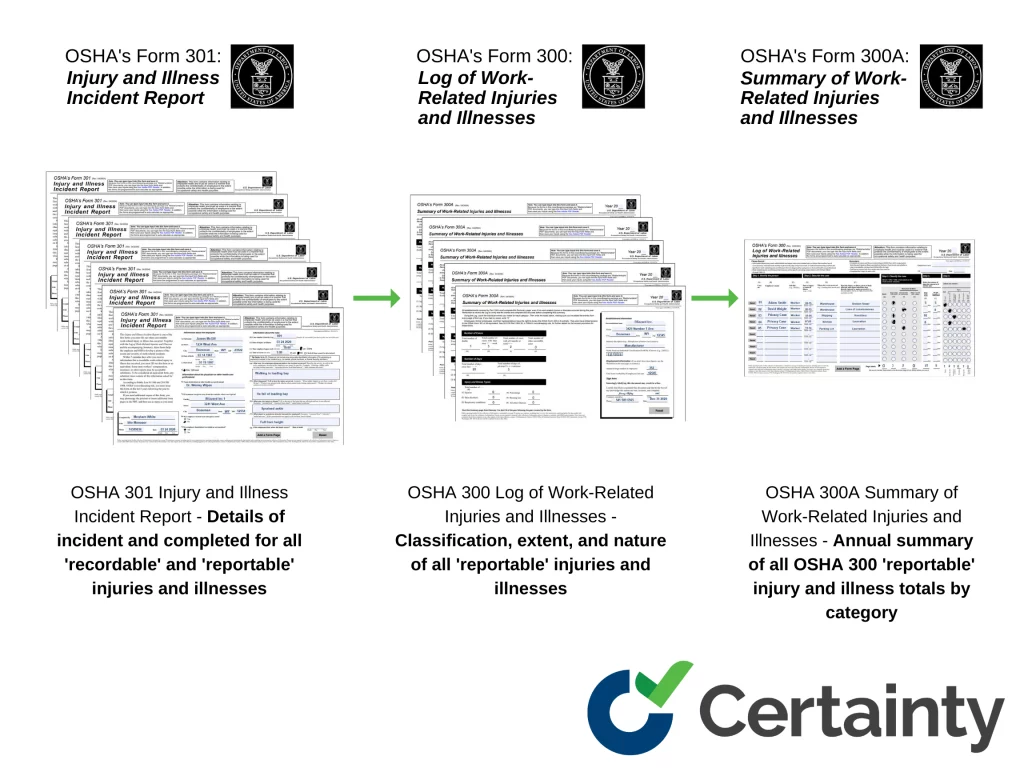The Occupational Safety and Health Administration (OSHA) was developed in 1971 to set and enforce a standard level of safe working conditions and prevent workplace injuries, illness, and work-related fatalities. And since its implementation, OSHA has helped to reduce workplace fatalities by 60%, while workplace injury and illness rates have dropped by 40%. A key factor as to why OSHA has been so successful is its injury tracking application and recordkeeping requirements. A byproduct of these efforts is the OSHA forms 300, 300A, and 301.
But, what is the purpose of each form? In this article, we discuss the differences, as well as the connections between the OSHA 301, 300, and 300A forms.


Want to share this image on your site? Click here to copy and paste the code.
<p><strong>Please include attribution to certaintysoftware.com with this graphic.</strong><br /><br /><a href='https://www.certaintysoftware.com/the-differences-between-osha-301-300-and-300a/'><img src='https://www.certaintysoftware.com/wp-content/uploads/2022/12/OSHA_s-Form-Flowchart.webp' alt='The differences between OSHA forms 301, 300, and 300a' width='600px' /></a></p>
OSHA 301 Form
The OSHA form 301 Injury and Illness Incident Report is used to detail any recordable and/or reportable injuries and/or illnesses that occur at the workplace. The terms ‘recordable’ and ‘reportable’ are important as OSHA has created specific recording and reporting criteria. An OSHA 301 report must be completed for any reportable injury or illness that results in:
- Death,
- Loss of consciousness,
- Restricted work activity or transfer to another job,
- Days away from work,
- Medical treatment beyond first aid,
- A significant injury or illness as diagnosed by a physician or other licensed health-care professional,
- Needlestick and sharps injuries,
- Medical removal of an employee,
- Work-related hearing loss, or
- Work-related tuberculosis.
Employers will also have to complete an OSHA 301 report if the event is recordable and involves:
- Cancer,
- Chronic irreversible disease,
- A fractured or cracked bone,
- Punctured eardrum,
- Respiratory condition, or
- Poisoning.
Employers can also use the OSHA 301 form to record the details of any work-related incident for data, metrics, and information that can assist with safety performance improvements, issues management and prioritization, root cause analysis, and general incident prevention initiatives.
Completing an OSHA 301 report does not mean that an employer is liable, non-compliant or at fault – it is simply the process of recording the details of incidents to provide the information that might be needed for OSHA 300 & 300A reporting requirements and continuous safety performance improvement activities across your business.

30+ Audit and inspection checklists free for download.
You must complete an OSHA 301 Injury and Illness Incident Report within seven (7) days of any recordable incident that occurs. Information necessary for these recordable cases includes descriptions of the affected individual, information on the health care professional, the type of recordable work-related injury, and details on the incident. Employers must keep completed OSHA 301 reports on file for five (5) years following the year of the injury, incident, or illness.
OSHA 300 Form
The OSHA 300 Log of Work-Related Injuries and Illnesses is used to classify injuries and illnesses and to note the extent and severity of ‘reportable’ work-related injuries. Employers must complete an OSHA 300 Log if an injury, incident, or illness involves any of:
- Death,
- Loss of consciousness,
- Restricted work activity or transfer to another job,
- Days away from work,
- Medical treatment beyond first aid,
- A significant injury or illness as diagnosed by a physician or other licensed health care professional,
- Needlestick and sharps injuries,
- Medical removal of an employee,
- Work-related hearing loss, or
- Work-related tuberculosis.
Employers must keep a separate OSHA 300 Log for each of their establishments or sites.
Specific pieces of information required in an OSHA 300 form include:
- Employee name (unless a ‘privacy case’)
- A unique case number
- The employee’s job title
- The type of injury sustained
- Number of days away from work
- Details of the incident
- The type of injury
Employers must notify OSHA within eight (8) hours if the injuries, incidents or illness resulted in death of an employee or the hospitalization of three (3) or more employees as a result of a work-related incident.
OSHA 300A Form
Submitted to OSHA once per calendar year, the OSHA form 300A Summary of Work-Related Injuries and Illnesses is an annual summary of all OSHA 300 ‘reportable’ injury and illness totals by category. Whereas the 300 form details the event and who was involved in the workplace incident, the OSHA 300A reporting requirements differ. With 300A, details such as the total number of events, DART (Days Away, Restricted, or Transferred), a total of the specific OSHA injury types, and business information such as the number of employees need to be included.
Employers must post the OSHA 300A summary (visible to employees) for a minimum period of 3 months by February 1st annually for OSHA 300 reportable events of the previous year.
Which Forms are Required to be Submitted to OSHA?
If your company has more than 249 employees, you will need – at a minimum – to submit OSHA 300 and 300a forms. These completed forms do not need to include personal information such as employee name, address, and medical professional names.
In high-risk industries, businesses with 20-249 employees must submit a 300a report to OSHA annually.
You may also be interested in:
The Top 5 Safety Metrics You Should be Tracking



